02 April 2025
|

Michael Newman, Managing Director of helicopter lifting contractor Helirig, explains why there is a growing demand for his company's services as the UK’s rooftops continue to reach skywards.
For more than a decade, a lifting solution like no other has been deployed across London, but you can be forgiven for not having noticed. Helicopter lifting operations are easily missed - no large cranes, minimum disruption and very little inconvenience to public or traffic. A helicopter lift can be completed in minutes rather than days, leaving barely a trace at street level.
The challenges faced by lifting contractors today in London and other UK cities are becoming increasingly multi-layered, inter-related and just plain difficult to overcome.
Buildings are getting taller and tall buildings are clustered together more densely, reducing street space below for the setting up of mobile cranes. Many city buildings are also reaching a certain age, and installed equipment, such as chillers and BMUs, are reaching end-of-life and need to be at least maintained, but often wholescale replacement is required. Equipment replacement strategies, if they exist, might have been developed decades ago and before taller neighbouring buildings were built, effectively closing down the possibility of siting large mobile cranes adjacent.
Streets are busier than ever, with TfL red routes, bus routes, emergency response routes all but preventing the siting of large cranes in any reasonable timeframe. And as the cranes required to reach the taller rooftops are getting larger and heavier, so too are the loads from their outriggers. It is often the case that these ground loads cannot be supported due to underground train lines, services or basements.
And then there’s the weather! On the occasion where the stars align and both street layout and city authorities allow for the set-up of a large mobile crane with jib extension, will the whole operation be winded-off due to the vulnerability of such cranes to even moderate windspeeds?
It is probably the speed of a helicopter lift that is such a vote winner with city authorities. A single lift is typically 3 to 4 minutes, so a batch of say 10 lifts can be completed within an hour. Without the need for heavy plant or equipment in the street, a lift can often be executed with a partial road closure and some simple traffic management.
Lead times of 4-6 weeks for planning a helicopter lift are realistic, allowing contractors to respond more effectively to equipment failures that require urgent attention, or to fit in with demanding construction schedules.
When planning a lift around a large mobile crane, contractors will generally reserve two or three weekend road closures, to protect against the risk of the operation being winded-off. Helicopters can operate in windspeeds in excess of 25mph, giving greater confidence that a lift can proceed as planned.
The unlimited height and reach for a helicopter often make it the obvious choice. A more recent valued application for helicopters has been for the positioning of equipment across the roofs of mega warehouses and distribution centres being constructed throughout the UK. Here helicopters can eliminate the need for multiple crane set-up positions around the building’s perimeter, which can be particularly problematic when hard-standing and access roads remain under construction.
Standards such as PUWER, LOLER and BS7121 govern the planning and execution of any load lifting operation. Helicopters are simply deemed Lifting Equipment under LOLER’s definition, so it’s appropriate that helicopter lifts are planned and carried out in accordance with these same regulations. Understandably, there is also a permitting process governed by the UK’s Civil Aviation Authority, and flight approvals managed by the National Air Traffic Services.
Examples of recent lifts
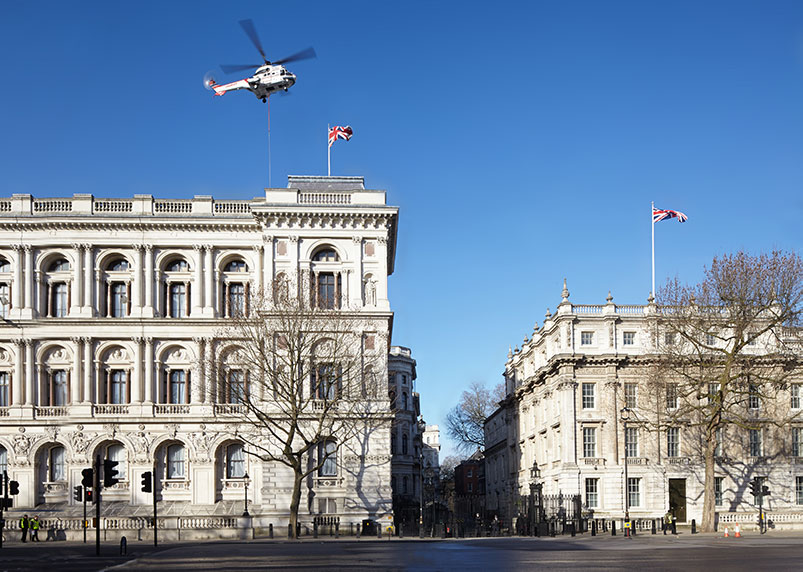
FCO Westminster: Installation of essential cooling equipment at the Foreign & Commonwealth Office at the heart of Westminster. A 500T crane with extended jib section was set-up in an adjacent street on two occasions and both times was winded-off. A helicopter lift was performed without the need for any road closure due to the ability to lift from within the FCO’s enclosed quadrangle.
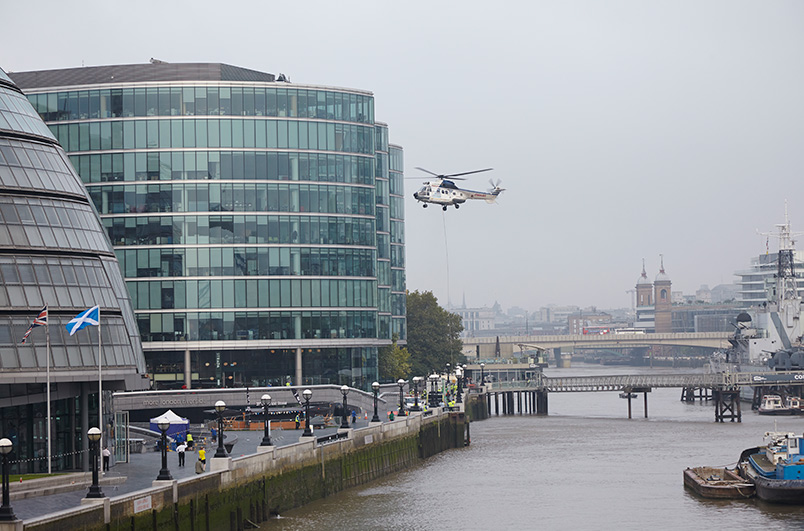
EY More London: Chiller replacement for the EY offices at More London Estates, adjacent to City Hall and HMS Belfast. At this location there is no realistic possibility of setting-up a mobile crane and so a helicopter was used on two separate visits to install 4 new chillers.
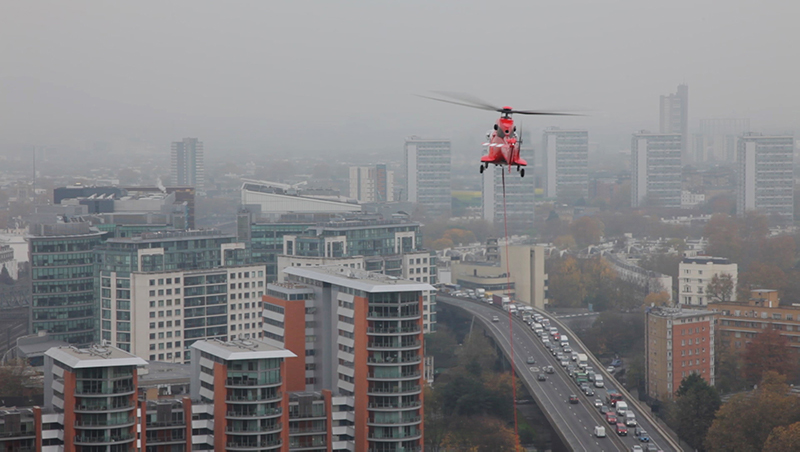
Hilton London Metropole Hotel: Chiller replacement for the hotel on Edgware Road. The crane required to reach the roof of this hotel would have required a full road closure of the Edgware Road (TfL red route) for at least 48 hours, and such a closure is very difficult to secure. The chillers were lifted from a small adjacent private site without the need for any road closures and the swap-out of two chillers was completed within about 15 minutes.
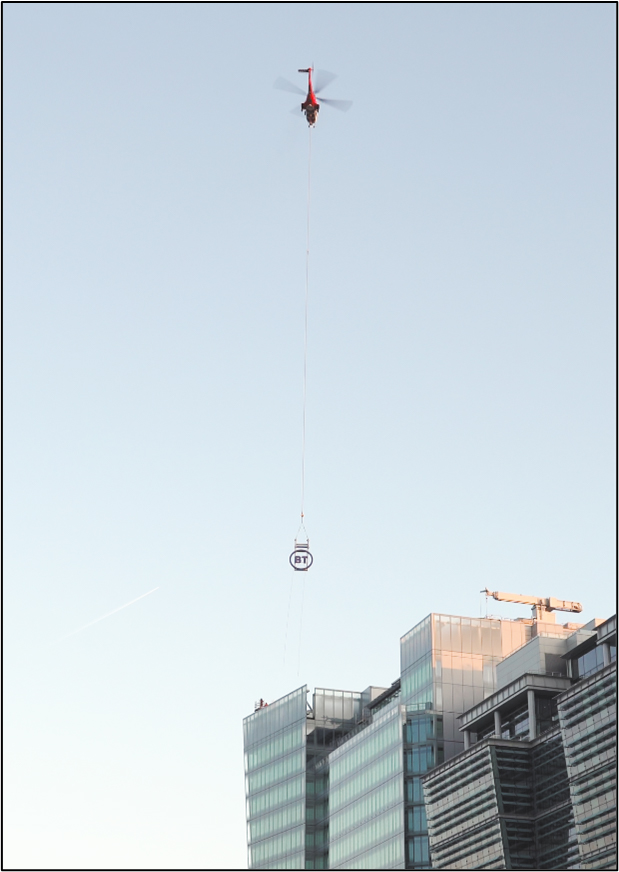
Three Snowhill: BT’s Birmingham Hub at Three Snowhill in the centre of the city required UPS, batteries and chillers lifted to the roof to provide secure power supply for an emergency services call centre. The lifting plan by crane called for two crane positions each closing major Birmingham arteries for two days. The helicopter lift closed the adjacent street for a few hours early one Sunday morning, providing minimum disruption.
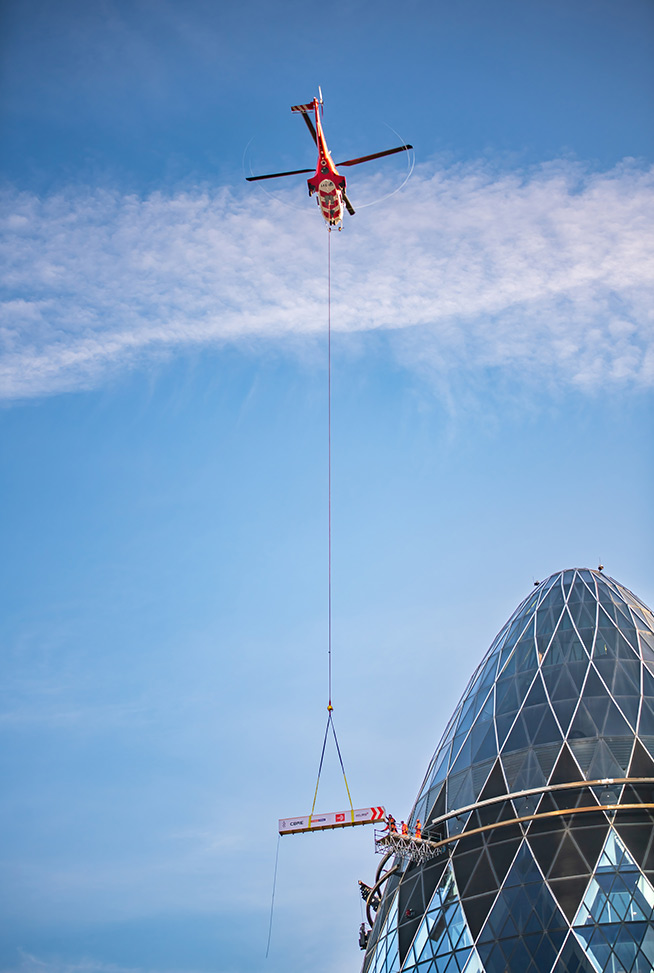
The Gherkin - At 30 St Mary Axe: The Gherkin required a new telescopic boom for one of the BMUs housed in its ‘garage’ 150 metres above street level. In such a congested corner of the City, there was insufficient space to set up the size of crane to reach to that level. The lift by helicopter was completed in under 5 minutes and St Mary Axe was closed for about 30 minutes.
CASE STUDY
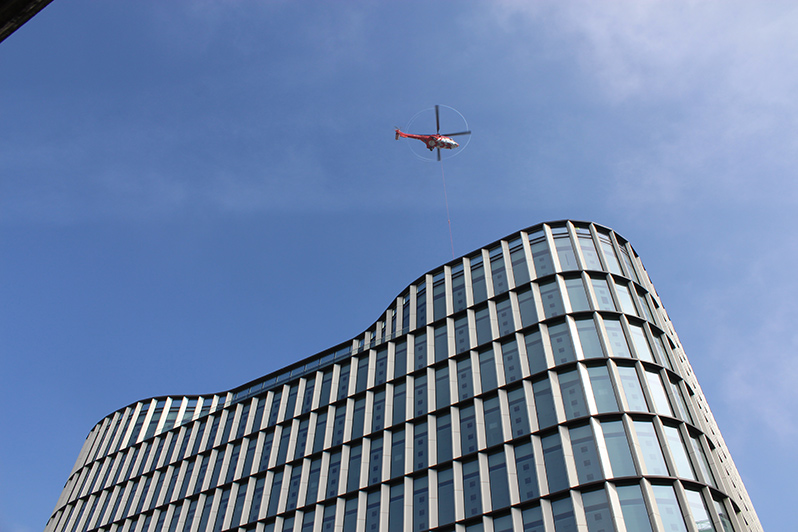
33 King William Street, City of London
33 King William Street was the first real estate purchase outside of the US for Wells Fargo, and it now serves as the company’s London HQ. It is one of the most well-connected office buildings in central London, close to London Bridge, Monument and Bank.
Helirig’s involvement came towards the end of the final fit-out of the building. The lifting of key HVAC plant to the roof required a weekend road closure on Upper Thames Street for the siting of a large mobile crane with luffing jib. However, the approved and long-awaited road closure on this busy London artery had just been revoked to allow for urgent gas mains repairs, leaving dates for completion, handover and occupancy all in jeopardy.
Meetings were arranged with representation from TfL, City of London Corporation and the Police, to agree a lifting plan acceptable to all parties. The final plan was fixed within a few days allowing for the lift to go ahead, subject to CAA approvals. It was agreed that we would maintain traffic flow on Upper Thames Street, albeit with some strategic traffic management, for the duration of the lifting. This could be achieved by having the pick-up point for all the loads in the small adjacent Arthur Street.
The City of London should be commended for their engagement in the process and the speed of their approvals. The prospect of 30 minutes of moderate disruption caused by the helicopter, compared to a full weekend road closure was a good incentive.
The speed of helicopter lifting requires a closer attention to detail during planning than is normal for a crane lift. Minutes and even seconds need to be made to count. Nowhere was this more important than at King William Street. With each lift being separated by only 3 minutes and the zone of pick-up restricted to an area of only a few square metres, each load needed to be driven accurately into position as empty trailers were removed.
A similar ‘choreography’ was required on the roof. With just a small opening to lower equipment through, each item of plant needed to be swiftly skated from the landing zone to make space for the arrival of the next item.
The helicopter was flying with a fixed 80 metre long line. This reduces any disturbances from rotor downwash on the roof; the manpower and the load being lifted. It also allows the helicopter to lower the hook down into a relatively narrow street for pick-up, while maintaining a safe distance between the helicopter and adjacent buildings.
Six items of plant were lifted in just under 20 minutes, with the heaviest making full use of the helicopter’s 4,000kg lifting capacity. With the last load delivered to the roof and the helicopter departed from site, the traffic management was lifted and in a matter of minutes life on the busy Upper Thames Street was returned to normal.
- Newbury-based Helirig is the UK’s leading contractor for heavy-lift helicopter lifting, and is a partner of global operator Heliswiss International. The company provides a full contract lift service including helicopter, ground crew, load preparation and slinging together with all the necessary lift plans, risk assessments, method statements and appropriate Civil Aviation Authority permits. The company has undertaken almost 200 helicopter lifts across the UK, including London, Bristol, Birmingham, Cambridge, Brighton and Luton.








